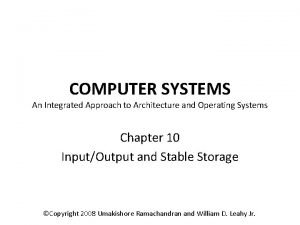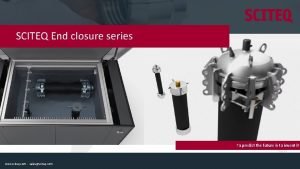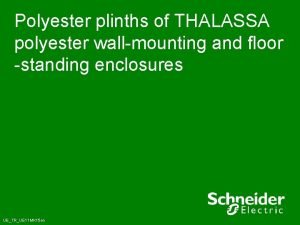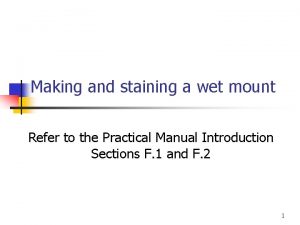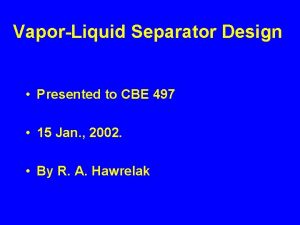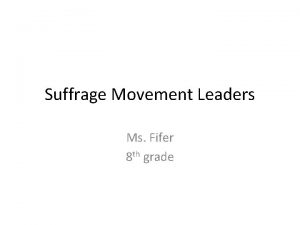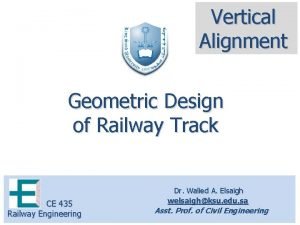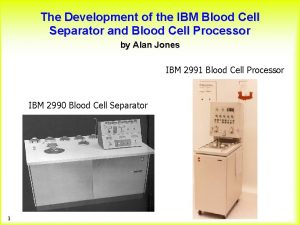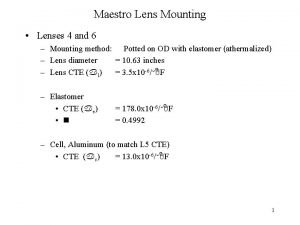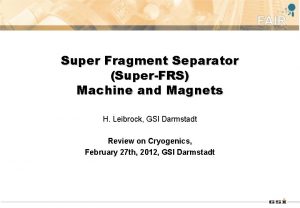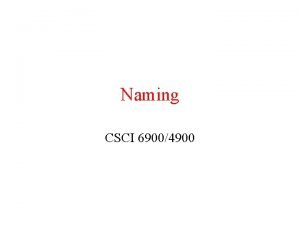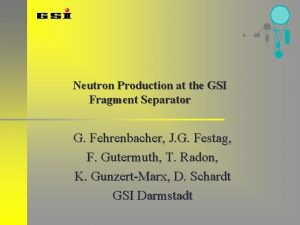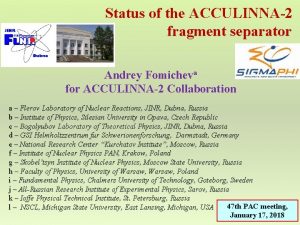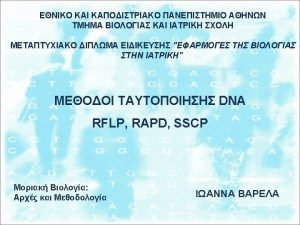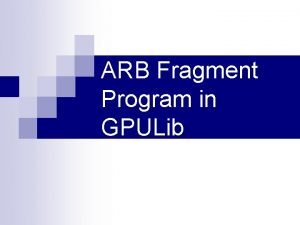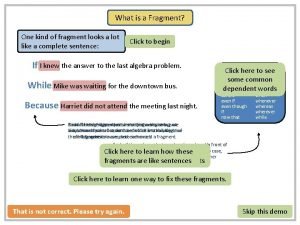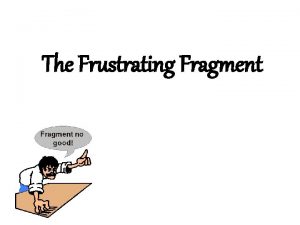Fragment Separator Design Component Alignment and Mounting Terrell





![South Wall Alignment Penetration [1] § Hot cell south wall • Prospective: Looking north South Wall Alignment Penetration [1] § Hot cell south wall • Prospective: Looking north](https://slidetodoc.com/presentation_image_h/db7ef3252d23938b959e4b90f784862a/image-6.jpg)
![North Wall Alignment Penetration [1] § Hot cell north wall • Prospective: Looking south North Wall Alignment Penetration [1] § Hot cell north wall • Prospective: Looking south](https://slidetodoc.com/presentation_image_h/db7ef3252d23938b959e4b90f784862a/image-7.jpg)


![Beamline Component Mounting and Support [1] Compatible with High-radiation Environment § Mounted rail supports Beamline Component Mounting and Support [1] Compatible with High-radiation Environment § Mounted rail supports](https://slidetodoc.com/presentation_image_h/db7ef3252d23938b959e4b90f784862a/image-10.jpg)
![Beamline Component Mounting and Support [2] Compatible with High-radiation Environment § Initial component installation Beamline Component Mounting and Support [2] Compatible with High-radiation Environment § Initial component installation](https://slidetodoc.com/presentation_image_h/db7ef3252d23938b959e4b90f784862a/image-11.jpg)










- Slides: 21

Fragment Separator Design: Component Alignment and Mounting Terrell Gee FRIB Mechanical Engineer This material is based upon work supported by the U. S. Department of Energy Office of Science under Cooperative Agreement DE-SC 0000661. Michigan State University designs and establishes FRIB as a DOE Office of Science National User Facility in support of the mission of the Office of Nuclear Physics.

Outline § Alignment • Hot cell penetrations • Hot cell and component fiducials § Component mounting § Prototype efforts • Mounting • Shielding § Summary T. Gee, Alignment and Mounting, Slide 2

FRIB Target Facility Reconfigured A-1900 Vertical Preseparator Hot-Cell Preseparator en m Frag ator par t Se T. Gee, Alignment and Mounting, Slide 3

Alignment Scope Component alignment in hot cell § Alignment and the hot cell • The hot cell is a portion of the entire FRIB alignment network • The alignment network connects the hot cell to the target facility and the target facility to the components located in the cell § Component alignment in hot cell • Mechanical systems that need to be mapped in the alignment network: » Vacuum vessels » Magnet assemblies » Beam line components (e. g. , post target shield) T. Gee, Alignment and Mounting, Slide 4

Alignment Penetrations Established Alignment Network and Fiducial Viewing § Alignment requirements • Experimental Systems Alignment Requirements Document (T 40300 -SP 000074) specifies the placement requirements; for Magnet Systems: » Transverse position (both magnet ends): +/- 0. 3 mm » Rotation about optical axis: +/- 0. 5 mrad » Longitudinal position: +/- 3. 0 mm § Derived requirements • Integration meetings with other groups further establish alignment criteria: » x ≥ 6 fiducial monuments transferred from each section of the alignment network » x ≥ 4 fiducial monuments attached to components located within the alignment network § Alignment perspective images N Final Penetration Designs N • 3 D-CAD tools were used to mimic the viewpoint of a laser tracker system • The images were used to create and finalize the penetration designs T. Gee, Alignment and Mounting, Slide 5
![South Wall Alignment Penetration 1 Hot cell south wall Prospective Looking north South Wall Alignment Penetration [1] § Hot cell south wall • Prospective: Looking north](https://slidetodoc.com/presentation_image_h/db7ef3252d23938b959e4b90f784862a/image-6.jpg)
South Wall Alignment Penetration [1] § Hot cell south wall • Prospective: Looking north toward the hot cell north wall Penetration Boundaries Tracker Beam Projection Image represents a tracker system positioned in the south wall T. Gee, Alignment and Mounting, Slide 6
![North Wall Alignment Penetration 1 Hot cell north wall Prospective Looking south North Wall Alignment Penetration [1] § Hot cell north wall • Prospective: Looking south](https://slidetodoc.com/presentation_image_h/db7ef3252d23938b959e4b90f784862a/image-7.jpg)
North Wall Alignment Penetration [1] § Hot cell north wall • Prospective: Looking south toward the transfer area of the hot cell Tracker beam projection Image represents a tracker system positioned in the north wall T. Gee, Alignment and Mounting, Slide 7

Alignment Beam Line Component Viewing Critical for Activated Components § Limited cell access • Once shielding is removed activated components restrict cell access – servicing completed via remote manipulation Fiducials for Vacuum Components § Remote viewing of the fiducial network • Viewing achieved using a laser tracker system » Identifying optimal fiducial location » Ensuring proper fiducial orientation » Maintaining line-of-sight capabilities for all monuments In Cell Fiducials § In cell fiducial placement • The constraints for mounting fiducials on components also apply to positioning fiducials around the hot cell T. Gee, Alignment and Mounting, Slide 8

Component Mounting Design Slide Assembly Overview Vacuum Vessel and Beamline Components Slide Assembly Magnet and Support System Support Rail T. Gee, Alignment and Mounting, Slide 9
![Beamline Component Mounting and Support 1 Compatible with Highradiation Environment Mounted rail supports Beamline Component Mounting and Support [1] Compatible with High-radiation Environment § Mounted rail supports](https://slidetodoc.com/presentation_image_h/db7ef3252d23938b959e4b90f784862a/image-10.jpg)
Beamline Component Mounting and Support [1] Compatible with High-radiation Environment § Mounted rail supports • Rail supports carry load through the vacuum vessel to floor below • The rail supports are embedded in the concrete below the vessel Support Rail § Kinematic mounting • Allows magnet assembly to be removed, serviced, and repositioned back into the alignment network • Coarse guide will locate components up to canoe sphere engagement during the yoke reinstallation process Kinematic Layout Beam Direction T. Gee, Alignment and Mounting, Slide 10
![Beamline Component Mounting and Support 2 Compatible with Highradiation Environment Initial component installation Beamline Component Mounting and Support [2] Compatible with High-radiation Environment § Initial component installation](https://slidetodoc.com/presentation_image_h/db7ef3252d23938b959e4b90f784862a/image-11.jpg)
Beamline Component Mounting and Support [2] Compatible with High-radiation Environment § Initial component installation • Slide assembly » Provides axial adjustments • Shimming system » Allows for vertical adjustments during the installation phase • Once aligned the slotted washers and slide assembly will be fastened into position Slide Assembly Support Rail § Post installation adjustments • Replaceable shims provide adjustment capabilities » Laser tracking will determine alignment correction and provide profile data for new shims » New shims with machined x-y offsets and thickness allow for six degrees adjustment Replaceable Shim T. Gee, Alignment and Mounting, Slide 11

Mounting Systems Under Evaluation § Option A: Slide Gib Slide Assembly § Option B: Slide Plate L- Gibs Note: The exploded assembly models and the smaller images shown reflect earlier designs and are for conceptual reference only; the larger images reflect current design T. Gee, Alignment and Mounting, Slide 12

Evaluation of Mounting Options Supported by Prototyping § Simulate the alignment environment and validate adjustment procedures – reduces risk • Alignment precision • Accuracy and repeatability • Component durability § Designs are used in the Beam Delivery System magnets of ASD Weighted Component Mounting Systems Mounting Fixture Mounting Assembly Prototype Details T. Gee, Alignment and Mounting, Slide 13

Local Fragment Separator Shielding Re-entrant Shielding Prototyping Supports Design § Test manufacturability and determine machining capabilities of the vendor needed ES Design Models § Evaluate best-case manufacturing procedures / techniques for creating the production assemblies § Test if tolerance can be met in manufacturing to achieve maximum gap size as defined by the Radiation Transport Group § Test expected flatness and parallel tolerances for the welded parts of the re-entrant shielding Shielding with Stand Prototype Components: Shielding Models T. Gee, Alignment and Mounting, Slide 14

Summary § FRIB mounting and alignment components are designed based on the imposed/derived requirements and system interfaces § Design validation through prototyping T. Gee, Alignment and Mounting, Slide 15

Back Up Slides T. Gee, Alignment and Mounting, Slide 16

Beamline Component Mounting Advanced § In vessel mounting approach • The kinematic mounting approach used throughout the hot cell: » Magnet systems, target and beam dump systems, in-vessel shielding § Magnet support design integrated • Cradle design serves as interface between magnet system and mounting adjustment system by providing the connection point for the kinematic alignment component • Cradle includes several features that allow for remote handling operations Magnet Support Cradle Design Evolution T. Gee, Alignment and Mounting, Slide 17

Magnet Cradle Design Advanced Trunion Plate Trunion Pin Trunion Plate Slider Added Guide Rod Minor Trim To Ribs Modified End Plates Moved Canoe Spheres and Shim Puck to 12” Each Side of Center (Red Surface) T. Gee, Alignment and Mounting, Slide 18

Component Support in Vertical Preseparator Section Designs Understood § Support structure • Magnet range in weight from approximately 25 tons to 130 tons • Existing portions of the NSCL magnet support systems were used as the baseline for the vertical preseparator in FRIB NSCL S 800 Dipole Support NSCL S 800 Triplet Support Magnets and Support Systems of the Vertical Preseparator T. Gee, Alignment and Mounting, Slide 19

Vertical Section of the Preseparator Triplet Support § Triplet support designs straight forward and advanced - updates as needed to follow detailed design of magnets. Angled Mounting and Support Stands Horizontal Mounting and Support Stands T. Gee, Alignment and Mounting, Slide 20

Vertical Section of the Preseparator Example 50º Dipole Support § Rigid platform for orthogonal adjusters to accurately alignment the dipole magnets § 1 st magnet needs sideway movement to make space for preceding triplet initial installation maintenance § Similar system mounts have been realized at NSCL North wall: Hot cell NSCL/FRIB Cyc. Stopper Details Approx. Weight: 200 Tons Approx. Size: 2. 0 M x Ø 4. 0 M Lower Support T. Gee, Alignment and Mounting, Slide 21
 Podaj oznaczenie literowe nukleozydu
Podaj oznaczenie literowe nukleozydu Gcg bioinformatics
Gcg bioinformatics Global alignment example
Global alignment example Pam1250
Pam1250 Global alignment vs local alignment
Global alignment vs local alignment Global vs local alignment
Global vs local alignment Disk scheduling algorithms
Disk scheduling algorithms Smoke detector use
Smoke detector use Radiographic errors in dentistry ppt
Radiographic errors in dentistry ppt End closure mounting
End closure mounting Polyester wall mounting
Polyester wall mounting Mounting slides
Mounting slides Vapor liquid separator design
Vapor liquid separator design Brandi conner
Brandi conner Maria terrell
Maria terrell Bullying prevention training
Bullying prevention training Terrell ward bynum
Terrell ward bynum Mary church terrell
Mary church terrell Trusted platform module advantages disadvantages
Trusted platform module advantages disadvantages Railway alignment design and geometry
Railway alignment design and geometry Rebec amalgam separator
Rebec amalgam separator Cobe 2991 cell separator
Cobe 2991 cell separator






